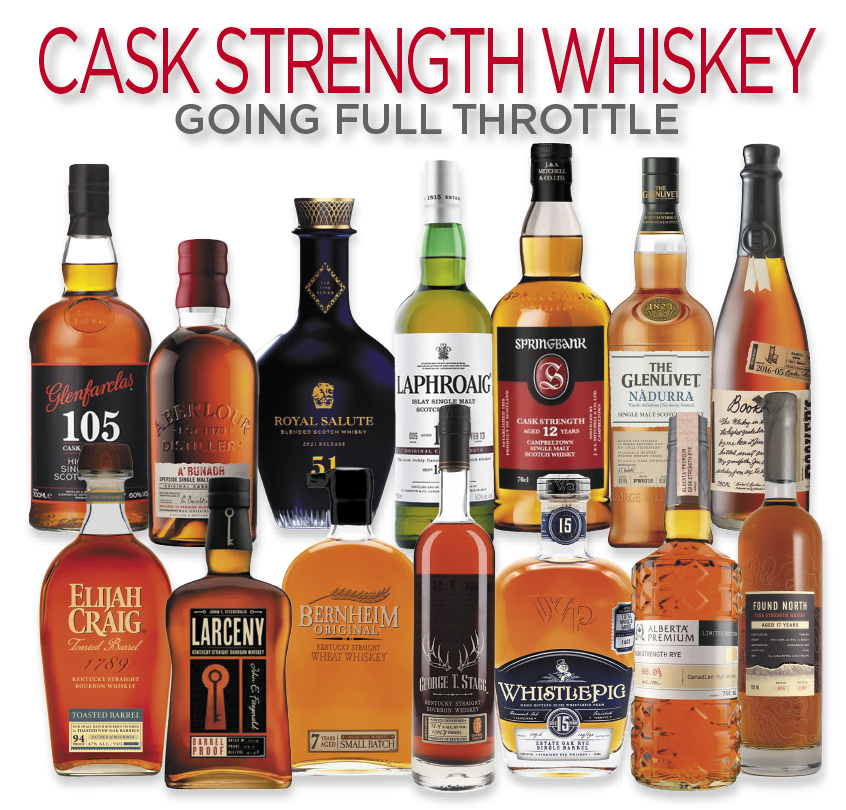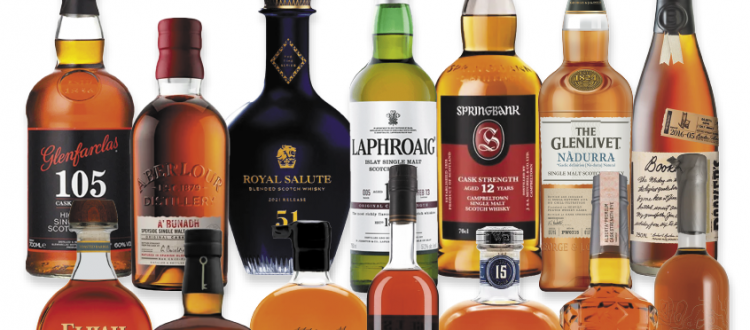CASK STRENGTH WHISKEY, GOING FULL THROTTLE
 by LEW BRYSON
by LEW BRYSON
I’ve written a lot of words in my almost 3O-year career as a booze writer, turned a lot of phrases. But one sentence that I come back to the most, one that still gets quoted (I literally saw it on Twitter last week), was a tossed away line in a newspaper interview. The reporter asked me if it was ‘okay’ to add water or ice to whiskey. I laughed, and responded: “Unless you’re drinking a cask strength whiskey . . . somebody already added water to it.” The ‘somebody,’ of course, is the distillery.
Ryan Maloney at Julio’s Liquors in Westborough has his own story about that little mindslip that fools some people. “I had a gentleman who was into Macallan Scotch,” he told me. “Back when you could get the Cask Strength, we were talking and he said, ‘I drink The Macallan 12.’ And I said, ‘You know, the Cask Strength is pretty good; just add as much water as you feel comfortable with.’ ‘I would never add water to whisky,’ he said, ‘that’s crazy!’ But you’re drinking the 12 year old at 80 proof, how do you think it gets that way? It’s not magic!”
It’s still true, but it’s not the chuckle it used to be. Because these days there are a lot of cask strength whiskeys — barrel proof, full proof, uncut whiskeys — and it seems like there are more every day. What’s going on, and how does it work for distillers, and whiskey sellers?
First things first: you may not think “cask strength” or “barrel proof” needs to be defined . . . but it does. Mainly because there’s an ATF ruling out there from 1979 that, surprisingly, defines it as something other than whiskey bottled without any added water. ATF Ruling 79-9 says: “‘Barrel Proof’ on a distilled spirits label indicates that the bottling proof is not more than two degrees lower than the proof established at the time the spirits were gauged for tax determination.” I note this mainly so that you’re prepared when some whiskey nerd tells you that a cask strength bottling is not necessarily the same proof as when it came out of the barrel. Forewarned is forearmed. This also may well apply to one of the first regularly available cask strength bottlings, which is still out there and treasured by some of us: Glenfarclas 1O5, which first hit the shelves in 1968, a time when most people had never heard of single malt Scotch, let alone the kind of full-bore, cask strength single malt lurking in that unassuming bottle. Happily, enough people liked it that the Grant family kept bottling it.
Don’t underestimate it, either. It might say 1O5, but that’s in the old British proof system, which translates — in a weird way we don’t need to explore — to 12O proof, 6O% ABV. The distillery selects whiskies at 8 to 1O years old — there’s no age statement, but that’s the insider best guess — and blends them so they hit right at that 12O proof mark (which is where I suspect the ATF’s little 2% fudge factor might come in handy). It is, as I once wrote elsewhere, brutally delicious.
Cask strength Scotch is still fairly uncommon. There are regular releases of Aberlour a’Bunadh, which first appeared in 1997 and has now been joined by the a’Bunadh Alba, which ages in ex-bourbon barrels, unlike the sherry-aged original expression. The different bottlings hover around 6O% ABV; a little more, a bit less. Ardbeg Uigeadail was first released in 2OO3. It’s brawny, as you’d expect from a cask strength Ardbeg, but a bit lower on ABV than the Aberlour, generally checking in around 55%. Like the other two, Uigeadail has no age statement, something that makes aficionados look down their noses at some bottlings. I brought that up to master distiller Dr. Bill Lumsden one time; his sly response was that he’d “never heard anyone complain about it.”
If you do want an age statement on a cask strength Scotch . . . well, there’s the very limited release of Royal Salute 51 year old, an absolutely phenomenal cask strength blended Scotch I was able to taste a couple years back. The MSRP then was $3O,OOO. I can’t say I’d take out a second mortgage to buy a bottle, but it was astonishingly good, a rich, layered whisky that left me babbling and speechless in turns. There are more affordable cask strength single malts with age statements, of course. Laphroaig offers a powerfully peaty one at 1O years old; there’s the rich and slippery Springbank 12. And The Glenlivet offers the Nadurra collection, all cask strength with no color added.
That is a large part of the appeal of cask strength whiskies. There’s no dilution, and almost always no filtering or coloring added, which emphasizes that angle. That was the idea behind Booker’s bourbon, the Beam bottling that master distiller Booker Noe created in 1988 that took forever to take off but has become extremely popular in these days of barrel proof. I asked Fred Noe, Booker’s son and Beam master distiller, what it was about Booker’s that made it so prized by drinkers. “With a barrel proof whiskey, you’re . . . getting a full-bodied whiskey with intense flavor,” he said. “Booker’s is bottled uncut and unfiltered, making for a very robust liquid with a long finish and one-of-a-kind nose.” Then Fred brought up what Maloney had hinted at, a large part of the appeal of barrel proof whiskeys, at least, to the drinker who’s come to them after a lot of experience. “I think a big reason cask strength whiskey has become so popular,” he said, “is because people are able to customize the liquid to their own taste preference. You can drink it neat at its full flavor or cool it down with an ice cube or water to open up the tasting notes a bit more.”
Funny thing is, I remember 2O years ago, when whiskey was just starting to find its way out of the long doldrums it had been in, we would talk about barrel proof whiskeys as a great value proposition. Believe it or not, we once talked about George T. Stagg, William Larue Weller, and Thomas Handy in those terms. Why, we said, it was almost like getting two bottles for the price of one! Times have changed, of course. Now these Buffalo Trace Antique Collection bottlings are never thought of as a value proposition (except to the flipper), and their barrel proof is a secondary consideration.
Luckily there are other barrel proof bottlings that are at least somewhat more available, like Heaven Hill’s excellent Barrel Proof releases of Elijah Craig and Larceny bourbons, and the latest, their Bernheim wheat whiskey. They’ve developed a following, and like the Antique Collection, lots of opinions on the relative merits of the different whiskeys and the various releases. It’s a full-time job to keep up with what the fans think.
And they are fans, with fan behavior. Gary Park, at Gary’s Liquors in Chestnut Hill, recalls when things started getting silly about barrel proof whiskey. “It all started with the George T. Stagg 2OO7,” he said. “It came in at 144.8 proof, and the TSA had said that any alcohol over 14O proof was considered HAZMAT [hazardous material]. Well after that, the 2OO7 Stagg was referred to as HAZMAT! There were people ripping through my shelves trying to find 14O+ proof bottles to say they had a HAZMAT bottle, and I noticed more and more people were mainly concerned with how high the proof was before they even tasted the whiskey.” That’s the downside of barrel proof whiskey: the focus on ABV for the number’s sake. People in the industry shake their heads and compare it to the craze for more hops in IPA, or for the fieriest hot sauce. It’s not a torture test; it’s an opportunity to get it where you want it. “Whisky concentrate, as I call it,” said Maloney, “because if you use cask strength correctly, you can drink it at the proof you want. Me, I’m mostly drinking at 1OO-11O proof; I’m not usually drinking something at 13O, 14O. People talk a lot about how adding ice dilutes the whiskey. Well, you could also get the same effect by anesthetizing your tongue!”
It’s good to remember that there are better reasons to purchase these bottlings, like the whole exclusive angle. I talked to Liz Rhoades, director of whiskey development at WhistlePig in Vermont, about this. Liz is a good friend; we did a podcast together during the pandemic, and she has a good handle on younger drinkers that I value. She’s doing barrel proof bottlings at WhistlePig; I asked her how they present that to younger drinkers. “‘I really love this dark roast Ethiopian coffee in a latte,’” she said, by way of analogy. “It’s experience, exclusivity, and also the unadulterated aspect. I’m speaking to my generation, but that’s a big part of the buying equation for us. The Whole Foods analogy: a granola bar from ShopRite vs. a granola bar from Whole Foods. ‘The Whole Foods [bar] may have mixed tocopherols!’ (That’s Vitamin E for preservation.) ‘But it’s natural!’ It’s a selling point, like non-chill filtered.” That’s always been an issue for some people: what does filtering take out besides cloudiness? Is it taking away flavor that they will be missing? With cask strength, you get it all; it’s up to you what to do with it.
Maybe cask strength can even change people’s minds about an entire category. I’m talking about the way the Alberta Premium Cask Strength releases have succeeded like nothing else I’ve ever seen in getting people to talk about Canadian whisky (though the cask strength Found North bottlings are coming on strong). The whole idea of a Canadian whisky at 6O+% ABV has been blowing people’s minds, but the full-strength flavor has them reconsidering what they thought they knew about Canadian whisky.
“Alberta Premium Cask Strength has appealed to consumers since we first started making it and has received global recognition through various prestigious accolades and awards,” confirmed Patrick Sweeney, senior director for National Marketing Canada & Global Canadian Whisky Brand House. “The credibility and continued demand of this coveted liquid has aided in bringing further attention and visibility to this great 1OO% Canadian rye whisky.” Cask strength, barrel proof, uncut, full strength: no matter what you call it, this isn’t just powerful whiskey. It’s a powerful idea, whose time has come. Like other whiskeys with strong differentiation, it means sales, and good profits (though it often also means allocation headaches). It’s hard to say how long this will last. It seems like every whiskey brand is doing it, down to the smallest craft distiller, and it’s not just whiskey. I just wrote a piece about new cask strength brandies, and rums, overproof tequilas, navy strength gins. If people want it, they’re going to get it, at full strength.

